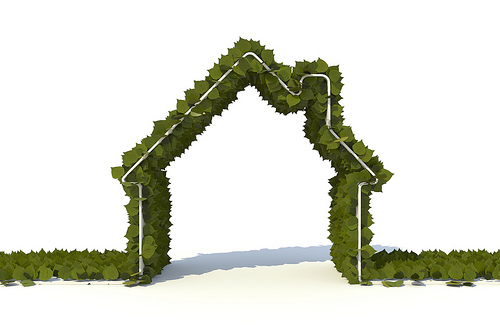Top 5 Tips For A Greener Home

Make Your Home a Little Greener: Top 5 Tips
Cutting back on energy consumption and taking steps to make your life more energy efficient is a top priority these days. For many, implementing this starts at home. Working to make your home greener has benefits extending beyond the obvious reductions in energy consumption, lower utility costs, and a reduced personal environmental impact–you get to simplify your life as well. One of the most surprising parts about transitioning to a more eco-friendly household is the ease with which you can make the transition to a greener home.
The best place to begin this transition is to look for sustainable materials and do some early planning regarding what you wish to accomplish. If you are building, find recycled and sustainably sourced materials. Or if you are just looking to improve the energy efficiency of your home through weather stripping or replacing windows, you can still make a big impact on the sustainability and efficiency of your home. You don’t have to spend a fortune on bamboo flooring and solar panels to do your part for the environment.
Upgrade Appliances-
This is probably one of the most obvious ways to make your home more efficient. Energy consumption from household appliances is one of the primary drivers of high utility costs and, consequently, fossil fuel production. While upgrading all of your appliances at once is probably not realistic or totally necessary, when you do replace them look for the Energy Star logo for more efficiency. Make sure the equipment is properly installed for optimal performance and savings. The best part about upgrading your appliances for more energy efficiency is that you could earn federal tax credits for installing certain energy efficient items in your home.
Conserve Electricity & Use Better Bulbs-
Believe it or not, turning off the lights when they are not needed can save energy– a lot. This is such an obvious and simple step to reduce your home’s energy consumption, but it is frequently overlooked. Turning on lights in a room, leaving the room, and then forgetting to turn them off is a common practice in most homes, but being conscious about flicking off the lights when they are not needed can lower utility costs and make your home a little greener. Light bulbs consume some 20% of a home’s energy, so doing your part to reduce that consumption is beneficial for everyone in the long term. Also, upgrade your light bulbs to energy efficient compact fluorescent as these bulbs will use up to 75% less energy than incandescent bulbs.
Use Natural Cleaning Products
Commercial cleaning products are a big strain on the environment and can be harmful to human health. Still, these toxic cleaning products are ubiquitous in most households. What many people fail to consider is where these products end up after use. Water supplies and landfills get filled up and contaminated with commercial cleaning products–leading to water contamination and large scale environmental degradation over time. Besides the impact on the environment, many commercial products like drain cleaner can damage your pipes by gradually eroding them. A good alternative for many of these cleaning products is a simple combination of hot water, white vinegar, and baking soda. This makes for an equally effective and less toxic cleaning solution for most areas of the house. While these three things are the foundational ingredients, there are a lot of variations of non-toxic products that can be used to clean different surfaces around the house.
Upgrade Water Fixtures and Washers
Water consumption is a major part of a home’s environmental impact. Reducing and making more efficient you home water use is a big part of greening up your home. The two best ways to begin addressing water use is through water fixtures and washing machines. Washing machines are one of the largest consumers of water in the home and waste many gallons of water, inflating your utility bills. Upgrading to a more water and energy efficient machine will help reduce costs and make your home a little greener. Also, while you’re investigating water use, consider investing in a more efficient showerhead. The newer, more water efficient fixtures use 2 gallons of water or less per minute. This 1 or 2 gallon reduction can help reduce water waste and utility costs every month. You can also control the water flow on other water fixtures by installing an aerator on faucets to mitigate water flow.
Seal Leaks and Insulate
This is probably not the most revolutionary or glamorous idea to improve the energy efficiency of your home, but it is very effective. Leaks and poor insulation in the home can lead to a significant loss of energy and raise heating and cooling bills drastically. By sealing any leaks and better insulating or upgrading on insulation, you can save some 20% on energy costs. Seal windows and upgrade to double pane glass on single pane windows. Add weather stripping to doors to keep cold air in during the summer and out during the winter. For insulation, determine where you need to insulate or upgrade the insulation and find the right R-value of insulation for that area of the home. Ensuring that the home is properly insulated and sealed in areas vulnerable to drafts is one of the simplest and most effective steps you can take to achieve a greener home environment.
Photo Credit: Creative Commons – StockMonkeys.com Related Post: _______________________________________________________________________________________________________ Author: Ben Vaughn has written for J&L Restoration on home energy efficiency tips, DIY home renovations, and landscaping tips for water conservation. _______________________________________________________________________________________________________












